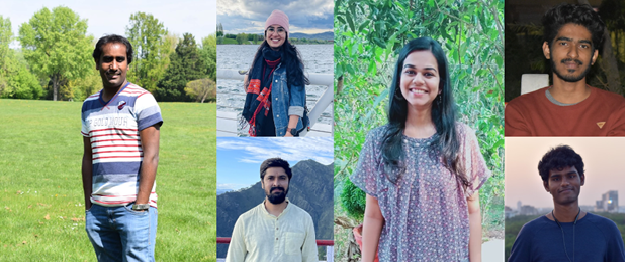Office Address
- Department of Earth and Environmental Sciences IISER Campus, Knowledge city Sector 81, SAS Nagar (Mohali) P.O Manauli India. PIN 140306
- headees@iisermohali.ac.in
I am Raju Attada, a faculty member in the Department of Earth and Environmental Sciences at the Indian Institute of Science Education and Research Mohali (IISERM) since April 2019. I specialize in teaching Atmospheric and Climate Science courses at IISER Mohali. My doctoral research, conducted at the Indian Institute of Tropical Meteorology, focused on numerical weather prediction for Indian summer monsoon rainfall. During my postdoctoral tenure at the Department of Physical Sciences and Engineering at King Abdullah University of Science and Technology (KAUST), I utilized a regional climate model to investigate the summer climate of the Indian and Arabian Peninsula regions. At present, my research group at IISERM is primarily engaged in advancing the physical understanding and prediction of climate in India across various time scales. We aim to achieve this through regional climate modeling and the analysis of remote sensing and ground-based observations. Our ongoing projects encompass enhancing sub-seasonal to seasonal climate forecasts, performing convective-resolving simulations of extreme weather events, including dust storms, and contributing to the development of Numerical Weather Prediction (NWP) through advanced data assimilation methods within the Weather Research and Forecasting model. Furthermore, I actively collaborate with both national and international research laboratories, and I am involved in outreach activities aimed at enhancing weather and climate research capabilities in India. More details of our research group available at
https://sites.google.com/view/wcmgiiserm/home
WeCliMB: https://sites.google.com/view/wcmgiiserm/home
ResearchGate: https://www.researchgate.net/profile/Raju-Attada
GoogleScholar: https://scholar.google.com/citations?user=3nYMkQgAAAAJ&hl=en
LinkedIn: https://www.linkedin.com/in/raju-attada-b421b6a5/
Twitter: https://twitter.com/rajuattada1
Orcid: https://orcid.org/0000-0002-6194-4561

Atmospheric processes and climate change take place on a wide range of spatial scales from global to regional and local scales. Our group aims at analyzing, simulating and predicting the regional weather and climate aspects, including extremes, over India using high-resolution regional climate models. The high-resolution information will be beneficial for climate assessments, to study the impacts of climate change on human and natural systems, and to develop national adaptation and mitigation strategies. The group is also focusing on understanding the regional/local weather and climate phenomena, and their variability and changes, through dynamical downscaling and analysis of observations. We are also working on developing cloud-resolving modelling systems of mesoscale convective systems and their predictions at sub-seasonal scales, and the future projections of extremes at regional and local scales. The group research activities at IISERM also involve the application of advanced data assimilation techniques to improve the simulations and forecast of regional weather extremes, which we are working on in close collaboration with the Climate Change Center at King Abdullah University of Science and Technology.
A broad list of research being conducted in the group includes the following:
| Name | Role | Thesis Title | Overview | Profile Photo |
|---|---|---|---|---|
| Nischal Sharma (PH19061) | PhD Scholar (Jan 2020-Present) Prime Minister’s Research Fellow |
Understanding the mean and extreme precipitation characteristics associated with winter precipitation over western Himalayas using datasets and high-resolution WRF modeling framework | Winter precipitation is observed in the northern parts of Indian subcontinent through December to March due to the passage of western disturbances embedded in the sub-tropical westerly jet stream. This precipitation is a primary irrigational source for agriculture and plays a critical role in replenishing the water resources in the northern plains and maintaining the snow cover of the Himalayan glaciers. Being thickly populated, North India is prone to heavy destruction due to the increased frequency and intensity of extreme precipitation events such as, flash floods, cloudbursts, landslides, avalanches, etc. We aim to understand and simulate the winter precipitation dynamics and its key mechanisms over the Himalayas at a range of resolutions, including cloud-resolving scales. |  |
| Rohtash (PH20017) | PhD scholar (September 2020- Present) Prime Minister Research Fellowship Recipient |
Deciphering and Simulating the Indian Summer Monsoon and Extreme Rainfall Events over the Western Himalayas | The Himalayas, also known as the Water Tower, are a high mountain terrain with a complex interaction between atmosphere and topography. The complexity of the terrain and the high meteorological diversity make this region the most attractive to the research communities. Due to the warming world, the changes in atmospheric conditions over the Himalayas cause extreme precipitation events, flash floods, cloud bursts, river flooding, and landslides. Aim of my research is to understand and predict the monsoon rainfall and extreme rainfall events over the Himalayan mountains and downstream regions. |  |
| Athira K S (PH20044) | P.hD. Scholar (January 2021 -Present) | Understanding Extreme Winter Weather over North India using observations and Climate model simulations | Under the present climate change scenario, there is a growing concern about the weather andclimate extremes which can impose serious impacts on human and environment. Cold waves areone such type of extreme winter weather events prominent during the boreal winter season(November to February). North Indian region is constantly exposed to a number of cold wave events each year. These cold waves can be very intense at times leading to extreme weather situations that can have various impacts including the effect on human health. The study mainly focuses on identification of cold wave events, the synoptic dynamics and the mechanism of their formation. |  |
| Sreehari K | Junior Research Fellow (June 2022 – Present) | Evaluation of impact of DWR observation on prediction of extreme rainfall events over NorthWestern Indian region using WRF variational data assimilation system | – |  |
| Deepak P | Junior Research Fellow (August 2022 to present) | Potential impact of moist and thermodynamics profiles on the prediction of extreme rainfall events in a cloud-resolving modelling framework. | Indian Summer Monsoon: Dynamics, thermodynamics, Simulation and Predictability: The Indian Summer Monsoon (ISM) is a complex weather phenomenon that brings heavy rainfall to the Indian subcontinent and surrounding regions from June to September, providing over 70% of India’s annual rainfall. While studies suggest that frequency and intensity of extreme precipitation events are on the rise over India, climate change is expected to affect the ISM, leading to even more extreme rainfall events, longer dry spells, and potential consequences for water and food security. Our research group focuses on studying the dynamic and thermodynamic characteristics of ISM extremes, aimed at enhancing our understanding of the physical processes driving those extreme events. We also aim to simulate ISM extremes using advanced modelling techniques such as the Weather Research and Forecasting (WRF) model and investigate the potential for improving forecasts through the assimilation of high resolution observation datasets such as satellite and radar data. |  |
2023
2022
2021
2020
2019
2018
2017
2016
2015
2014
2013
NIL